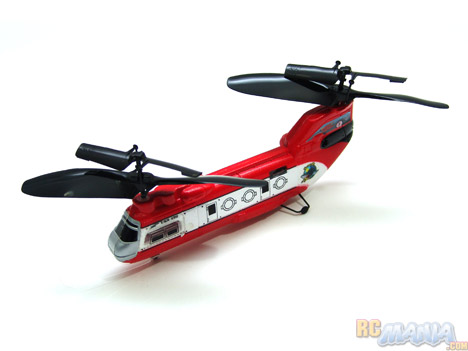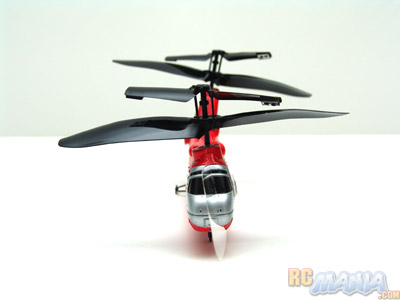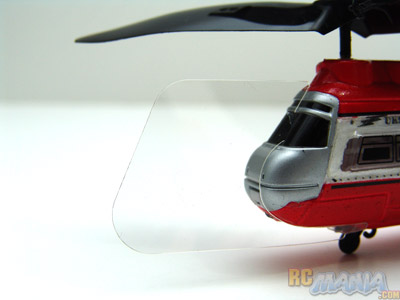Air Hogs Twin Thunder

Street Price: $54.99 US (varies)
Manufacturer: Spin Master
Mfgr's recommended min. age: 12+
Our recommended age range: 10-13
Primary use: Indoors
Radio: n/a - infrared
Includes:
- Micro heli
- Transmitter / charger
- Spare stabilizer fin
- Instructions
- 6 AA batteries for the transmitter
Initial Impressions
By now, I've seen more than enough barely different variations on the micro heli theme. Finally the Twin Thunder has come along and done something dramatic by using not one, but two main rotors, with no tail rotor! It's in the style of the famous Boeing CH-47 Chinook helicopter, the style of which it duplicates actually pretty accurately. At least when you look at it from the side. From the front, though...
 |
How funky is that? One rotor leans way to one side, the other to the other side. Probably necessary to help counteract a natural tendency of the craft to spin in one direction since the two rotors spin the same way. Maybe this could have been solved by making the rotors spin opposite directions like on the real Chinook, but that would have required a whole new rotor design which would have raised the cost.
Now, I did say the leaned rotors only help prevent constant spinning. There are two more things that contribute to this, and you might not notice them if you just see the Twin Thunder in its box at a store. At both the front and rear ends of the heli are long, clear plastic fins, angled with the rotors. The front one is detatchable (and there's even a spare included), but the rear is not.
 |
Preparing to Fly
Preparation is just the usual for micro aircraft. Charge the craft from the cord that's built into the controller, and you're ready to fly.
Testing
You might think the twin rotor design is just for style, but there's more to it. While most micro helis only go up & down and turn left & right, with forward motion being a constant based on the weight balance of the heli. With only two axes of control, these simple craft use a 2-channel transmitter. The Twin Thunder has a 3-channel transmitter. The left stick controls your up/down movement as usual and the right stick controls right/left turning as usual, but then the right stick can also be pushed forward to give you fast forward flight. Getting used to the responsiveness of the controls takes patience, and you need to make small movements with the control sticks and not over-correct. In a small room, the heli creeps forward slightly on its own and you really don't need to use the forward control at all. If you have enough space and want to get some speed going, I don't recommend just pushing the right stick all the way forward and keeping it there. You'll lose altitude and keeping it under control when it's time to slow down or turn can be really difficult. In fact, any time you move at all, the Twin Thunder loses some altitude, so you have to get into the habit of increasing the throttle (pushing the left stick forward) slightly any time you turn or move forward. There are also two fine trim knobs on the controller, one for turning and one for tunining the forward/back motion. All of this extra complexity is the reason for the recommended usage age being 12+ versus 8+ for the simpler 2-channel helis.
Ah, but the Twin Thunder has one last surprise up its sleeves. I don't know how they got this feature in there, but there's a real working searchlight under the nose, and you can turn it on or off whenever you want -- from a button on the controller! It's a bright bluish LED light and really shines a realistic spotlight down & forward a bit. Very cool!
Video
(Click a video a second time to view it larger in a new window.)
Conclusion
When the Twin Thunder was first released (and in some stores even as of this writing) the retail price was around $75 US. At that price, it's not worth it. For just $20 more you can get a hobby-class RC heli from XHeli.com with not 3 channels, but 4, with all batteries included, upgradable parts, and way more control. However, a few stores like Wal Mart have brought their price down as low as $49, which makes the Twin Thunder even cheaper than the Reflex, with a better-looking design and more speed and controllability for more intermediate pilots. I think that's a perfect price, and you get a good value. The Twin Thunder is definitely not for first-time fliers, but it's perfect for anyone who's ready to step up from 2-channel micros, or for an experienced hobbyist looking for something small and cheap to mess around with indoors.





